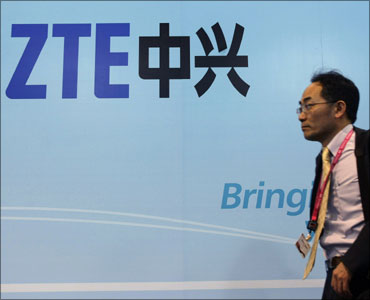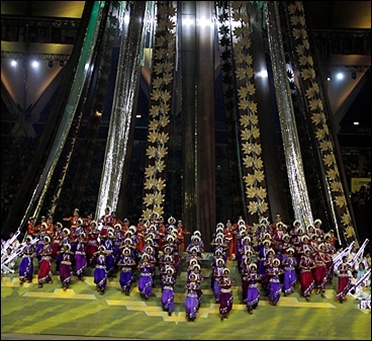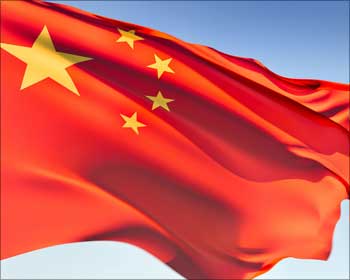Photographs: Courtesy, Business Standard Sanjeev Nayyar
Did you know that Indian operators import virtually all the telecom equipment needed for setting up a network?
These imports were Rs 46,158 crore (Rs 461.58 billion) in 2008-09 and account for about 13 per cent of India's current trade deficit.
As of September 2010, India had 684 million mobile subscribers. By 2015, this number is expected to cross 1.2 billion, including 115 million 3G users, growth that is expected to fuel demand for telecom equipment worth $70 billion to $100 billion till 2015.
A big inflection point would be 3G investments, which would be approximately $15 billion across operators. Therefore, India has the world's second-largest wireless market after China.
Only a few years ago, China was in a similar situation. Today, Huawei and ZTE are reputed vendors.
Instead of knowing what India did not do, it would be useful to know what it can learn from China.
. . .
How to create Indian Huaweis & ZTEs
Photographs: Reuters
First, the government started the 'China 863' programme or State High-Tech Development Plan to develop new technologies.
It forced vendors like NSN and Ericsson to manufacture with 95 per cent local staff and 100 per cent local content. Huawei and ZTE came up through domestic partnerships that NSN and Ericsson set up. Operators supported them through forced purchases for five to seven years.
China also took the lead by defining its own 3G standards (TD-SCDMA) and developed an ecosystem for manufacturing network infrastructure and devices.
Since telecom operators are controlled by the government, they created a window for indigenous R&D products.
Chinese vendors ensured that a certain technology that was not in the portfolio would be developed in-house.
For example, China delayed the 3G rollout until domestic manufacturing competence was in place. Tax breaks, research grants and cheap loans from state-owned banks helped reduce cost.
. . .
How to create Indian Huaweis & ZTEs
Image: The Commonwealth Games opening ceremony in New Delhi.Photographs: Reuters
What must we do to build a telecom industrial complex?
First, develop a political will and acceptance of a long-term policy by ruling and key opposition parties. Every vendor wants uniform policies, irrespective of which party is in power.
To avoid a Commonwealth Games-like fiasco, the mission to produce locally should be headed by a CEO, a respectable name from the telecom industry, who holds rank of minister of state.
To remove inter-departmental hurdles, a group of ministers consisting of the finance, home and communication ministers and the CEO should meet monthly.
Second, lack of R&D and testing facilities is a weak link in India. Developing R&D could be a joint effort between, say, ISRO, BEL, the IITs and IT companies.
To this end, a dedicated R&D fund could be created from the auction of spectrum and the balance in the underutilised USO fund, which was Rs 14,157 crore (Rs 141.57 billion) on March 31, 2010.
. . .
How to create Indian Huaweis & ZTEs
Photographs: Reuters
One of the critical resources for a telecom start-up is access to testing facilities.
The government should develop processes for facilitating access to a national telecom test-bed (such as C-DOT, ALTTC) and state-of-the-art private test-beds (like that of Bharti, Vodafone or Reliance) and support the creation of standards and the affiliation with standard creation bodies.
Third, the regulatory framework for manufacturing equipment needs to change. The company must be a joint venture between a foreign vendor and an Indian partner where the latter holds a favourable stake.
Transfer of technology and software codes must be mandatory. Also, the joint venture must start with 60 per cent indigenisation in year one, going up to 95 per cent in year three.
Between years one and three an offset policy should be in place that requires 20 per cent in the form of core Indian parts. Also, 95 per cent of the employees in the joint venture must be local.
Equipment sold by the joint venture to Indian operators should be given a price preference of, say, 20 per cent, like Bhel used to get in power equipment.
. . .
How to create Indian Huaweis & ZTEs
Photographs: Reuters
Like the Indian software industry, telecom equipment joint ventures must be supported by incentives. Industry sources say just as the diamond industry is allowed to import raw stones for cutting and polishing, import of all base components (PCBs, chips) should be allowed duty-free subject to reasonable value-addition norms.
Allowing external commercial borrowing for working capital, equalising central sales tax and VAT on equipment sales at 2 per cent, allowing a 10-year tax holiday but exempting these joint ventures from Minimum Alternate Tax would also help.
The benefits of producing locally are manifold. One, the multiplier effect of approximately $100 billion worth of equipment bought would be 2.5-3 times. It would create at least 75,000 skilled jobs and 250,000 unskilled ones. It would help reduce India's current account deficit.
The indigenous manufacture of equipment would also make India less susceptible to threats by any country. During the recent stand-off between China and Japan, the Chinese retaliated by delayed export of rare earths to Japan.
Also, as operators like Bharti acquire a global footprint a localised equipment industry means they can source equipment from India.
The writer is managing consultant, Surya Consulting.
*Some recommendations in this article are borrowed from industry's response to Trai's consultation paper on the issue.







article